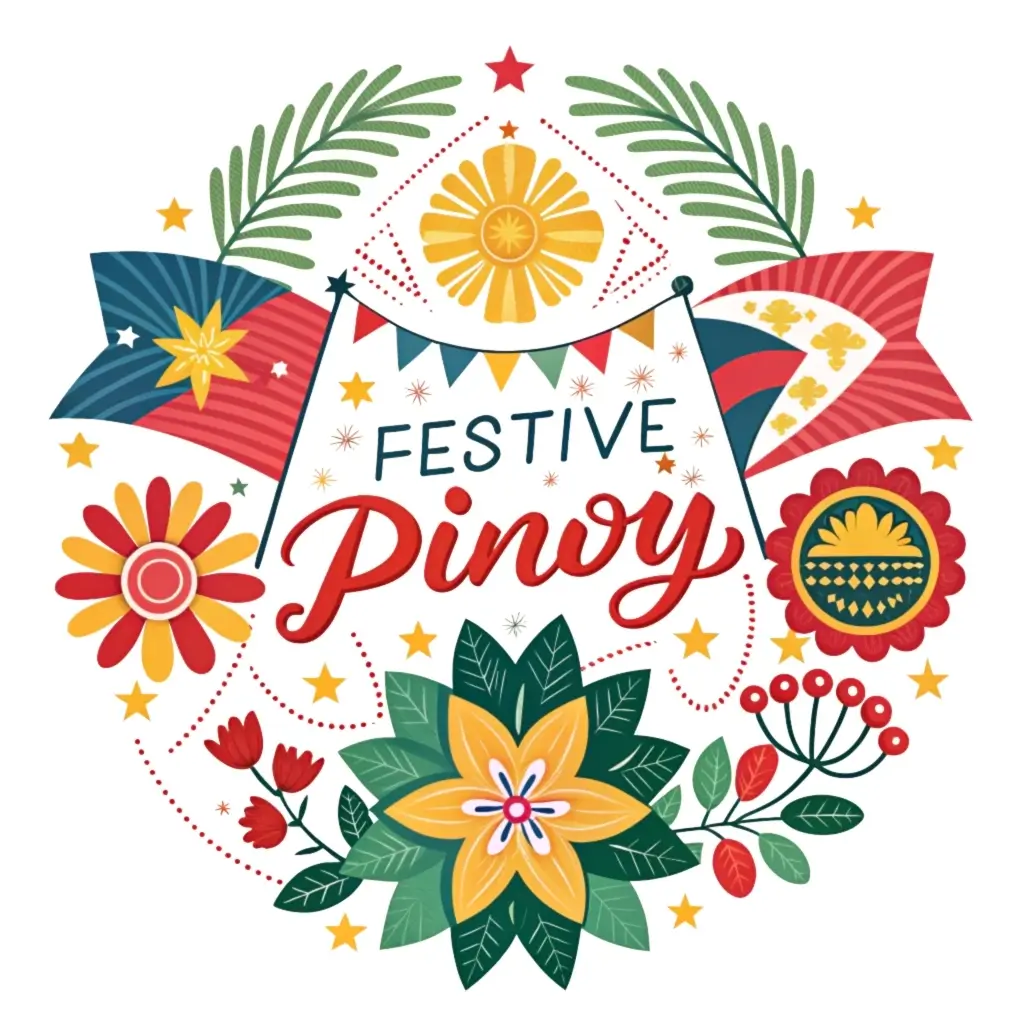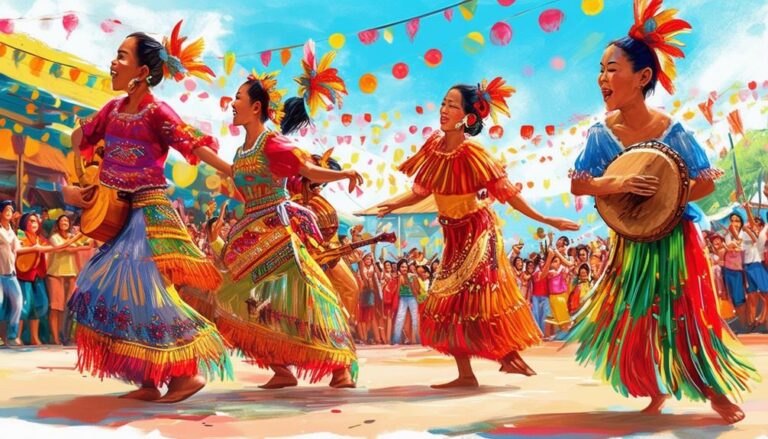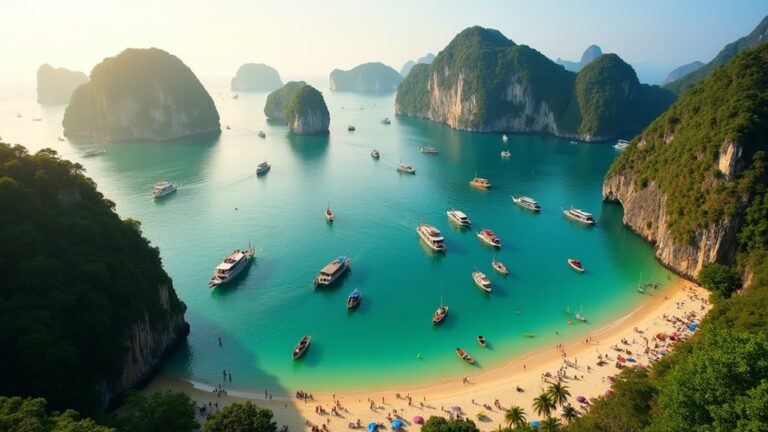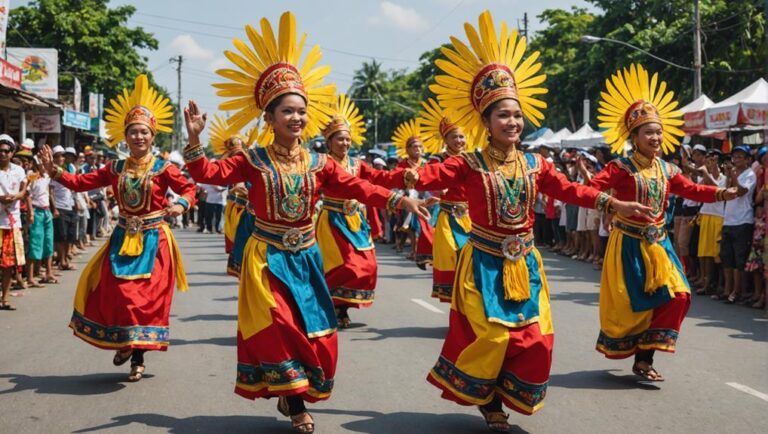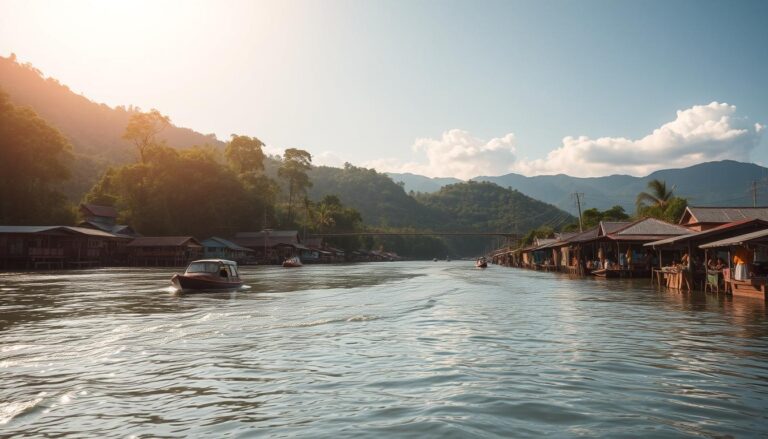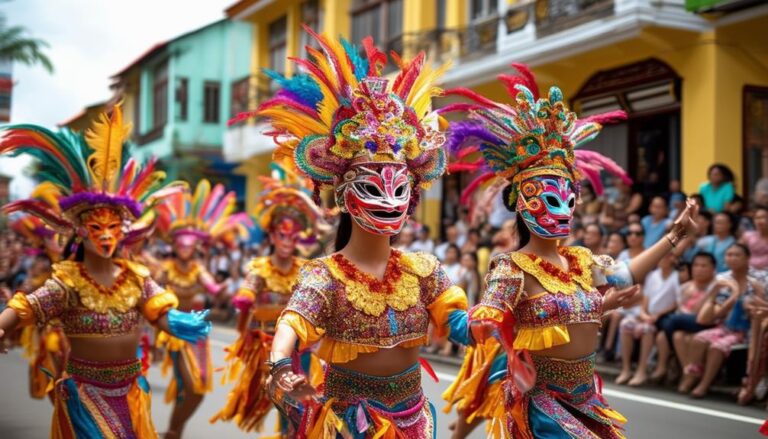Kadayawan Festival Philippines
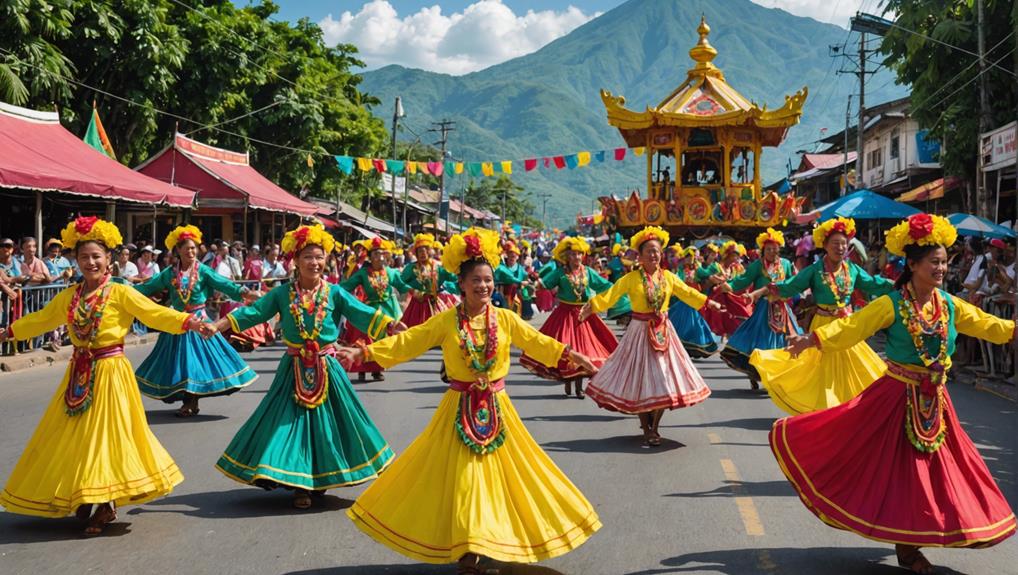
You’ll discover the Kadayawan Festival in Davao City, Philippines, steeped in the rich heritage of its 11 indigenous tribes. Initiated as a tribal ritual of thanksgiving for bountiful harvests, it’s evolved under government patronage into a grand cultural showcase. Vibrant performances like the Indak-Indak sa Kadalanan feature intricate street dances, while the Pamulak sa Kadayawan parade exhibits elaborate floral floats. Each event not only fosters community engagement but also serves as a dynamic platform for cultural preservation.
Exploring further reveals how this festival merges traditional practices with modern celebrations. The Kadayawan Festival, for example, highlights indigenous artistic expression through art exhibits and craft fairs. Echoes of the Kaamulan Festival in Mindanao are also visible in Kadayawan’s colourful costumes and decorations. This experience showcases the region’s cultural richness, allowing visitors to engage with and celebrate indigenous traditions.
Key Takeaways
- Kadayawan Festival is a vibrant celebration of Davao’s indigenous tribes, culture, and bountiful harvests.
- Key events include Indak-Indak sa Kadalanan (street dancing) and Pamulak sa Kadayawan (floral float parade).
- The festival serves as a platform for cultural preservation and showcases tribal dances, costumes, and traditions.
- It takes place in Davao City, offering travelers a rich experience of cultural diversity and local cuisine.
- Festival activities promote community engagement and provide insight into the indigenous cultural heritage of the region.
Kadayawan Festival At A Glance
| Aspect | Details |
|---|---|
| Name | Kadayawan Festival |
| Location | Davao City, Philippines |
| Type | Thanksgiving and cultural festival |
| Timing | Celebrated annually in the third week of August |
| Purpose | To give thanks for nature’s gifts, celebrate cultural heritage, and promote unity among the city’s tribes |
| Previous Name | Apo Duwaling Festival (named after Mt. Apo, the durian fruit, and Waling-waling orchid) |
| Historical Background | First encouraged in 1970 by Mayor Elias B. Lopez to highlight tribal thanksgiving rituals; renamed “Kadayawan” in 1988 by then Mayor Rodrigo Duterte |
| Major Highlights | – Indak-Indak sa Kadalanan: Street dancing featuring indigenous costumes and dances<br>- Pamulak Kadayawan: Floral float parade |
| Participating Tribes | Eleven indigenous tribes of Davao City, including the Lumad and Moro communities, showcasing diverse cultural heritage |
| Key Symbols | Mt. Apo (highest peak in the Philippines), Durian (fruit of Davao), and Waling-waling (native orchid and cultural emblem) |
Festival History
The Kadayawan Festival, officially named in 1988 by then-Mayor Rodrigo Duterte, celebrates Davao’s rich indigenous traditions and thanksgiving rituals. This festival reflects the enduring heritage of the Lumad and other indigenous communities in the region. Initially, the festival served as a tribal thanksgiving for a plentiful harvest, with rituals preserved through generations.
Government support has expanded these tribal traditions into a city-wide festival. Originally called Apo Duwaling during the martial law era to promote unity, it was later renamed Kadayawan under Duterte’s administration, focusing on cultural preservation and inclusivity. This renaming honoured the contributions of all indigenous communities to Davao’s cultural identity.
A main attraction, Indak-Indak sa Kadalanan (street dancing), presents traditional dances that symbolise life, nature, and revered spirits, bringing together various sectors of Davao’s society. This event goes beyond performance; it’s a powerful expression of cultural pride and resilience.
Participating in the Kadayawan Festival supports these community-led preservation efforts. Every dance, costume, and ritual reflects Davao’s history, influenced by martial law and enriched by efforts to honour indigenous legacies.
Cultural Significance
The Kadayawan Festival holds deep cultural importance for the people of Davao, serving as more than a festive event; it is a heartfelt tribute to indigenous traditions central to the region’s identity. Rooted in Lumad heritage, the festival honours the resilience and richness of Davao’s native cultures.
Central to the Kadayawan Festival are the tribal dances, which convey stories and traditions passed down through generations. These dances are not mere performances but expressions of heritage, each movement reflecting narratives from the past. The vivid costumes, unique to each tribe, showcase Davao’s cultural diversity, bringing its history to life through colour and symbolism.
The festival is also a time of gratitude for the natural abundance of the land. The community gathers to celebrate the harvest of fruits, flowers, and resources that sustain their lives. This sense of unity is tangible, as people from all walks of life come together, embodying the strength of community bonds.
Through Kadayawan, Davao celebrates more than a harvest; it celebrates its people, heritage, and future. This festival is a vital platform for preserving and sharing cultural stories, ensuring that the past is not forgotten but shared vibrantly and proudly. In doing so, it keeps Davao’s spirit alive in the hearts of its people and the many who join these annual celebrations.
Main Events
Reflecting on the cultural richness of Kadayawan, let’s look at the main events that bring its vibrancy and community spirit to life. Each event uniquely honours Davao’s heritage and indigenous traditions. The Indak-Indak sa Kadalanan, a street dance competition, is more than an artistic display. It’s a lively performance of tribal dances, with participants in colourful costumes sharing stories of life, nature, and revered spirits.
The Pamulak sa Kadayawan, a floral float parade, highlights Davao’s natural beauty with elaborate floats adorned with fresh flowers and local harvests. This event not only engages the senses but also celebrates the region’s agricultural abundance, a central theme of the festival’s origins.
Here’s a quick rundown of the main events that you’ll witness:
| Event | Description |
|---|---|
| Indak-Indak sa Kadalanan | Street dancing showcasing tribal dances and vibrant costumes. |
| Pamulak sa Kadayawan | Floral float parade highlighting Davao’s rich flora and agricultural heritage. |
| Hiyas sa Kadayawan | A beauty pageant that celebrates the intelligence and cultural attire of Davao’s indigenous women. |
| Kaan Dawet | A culinary market offering traditional food, emphasizing the culinary delights of Davao. |
These features create a festive atmosphere that fosters community engagement, drawing locals and tourists alike into a collective celebration of life and culture. Through these events, the Kadayawan Festival not only preserves the legacies of its tribes but also strengthens the communal ties within Davao, making it a vibrant cultural and social experience.
Community Participation
Community involvement profoundly enriches the Kadayawan Festival, as people from all walks of life actively contribute to its diverse and lively events. Here, exploring indigenous traditions and local enthusiasm forms the foundation of this cultural celebration. Attending the festival, you become part of a dynamic cultural exchange rather than just a spectator.
The spirit of ‘Kadayawan’ is deeply reflected through:
- Indigenous traditions: Tribal performances convey stories through the rhythmic beats of traditional music and the expressive movements of folk dances, embodying the heritage of Davao’s indigenous communities.
- Artistic collaborations: Local artisans and artists join forces, creating a blend of visual and performing arts that represent the essence of Davao.
- Community engagement: Every event, from street dances to art displays, resonates with the energy of local communities, each contributing a distinct touch to the celebrations.
- Cultural exchanges: Interactions with people from diverse backgrounds enhance understanding and appreciation of the cultures that make the festival unique.
Traveler’s Guide
To make the most of your visit to the Kadayawan Festival, planning your travel and accommodations in advance is essential, as Davao City becomes bustling with activity during this celebration. The festival offers a vivid display of cultural diversity, with Indigenous showcases and tribal performances filling the streets with colourful costumes and rhythmic dances that reflect the rich heritage of the area.
As you explore the festivities, take part in activities that celebrate Indigenous cultures. This isn’t just about observing but engaging, an opportunity to learn about the rituals and histories of Davao’s 11 tribes. Don’t miss the festival cuisine, especially dishes featuring local fruits like durian, which offer a delicious insight into the region’s agricultural abundance.
The Kadayawan Festival is also a great chance to enjoy nature. Beyond the lively events, Davao’s nearby serene landscapes provide a peaceful retreat when you want a break from the crowd, highlighting the festival’s dual role in promoting cultural heritage and natural beauty.
Finally, the festival’s dynamic celebration of cultural diversity through artistic and community activities makes each visit enriching. With early planning and active engagement, you’ll gain a deep appreciation for both Davao’s cultural and natural offerings.
Local Attractions
While enjoying the Kadayawan Festival, take the opportunity to explore Davao’s iconic landmarks, which provide deeper insights into the city’s culture and heritage. Must-visit sites include Mount Apo, the Philippines’ highest peak, which offers both challenging hikes and breathtaking views. People’s Park is another local favourite, with its lush landscapes, sculptures, and displays of native art, making it a perfect spot to experience Davao’s artistic spirit.
For food enthusiasts, Davao’s culinary scene is diverse and abundant. You can sample local delicacies at street stalls, such as grilled tuna, kinilaw (a Filipino ceviche), and the famed durian fruit, which Davao is known for. If you’re looking for a more refined experience, Davao’s high-end restaurants blend traditional Filipino flavours with modern twists, often featuring fresh, locally-sourced seafood and exotic fruits.
Davao also caters to adventure lovers with its outdoor attractions. Beyond Mount Apo, Eden Nature Park offers zip-lining, hiking trails, and a relaxing view of nature, while Samal Island provides beautiful beaches and diving spots just a short boat ride from the city. These destinations allow visitors to enjoy the region’s stunning biodiversity, from coral reefs to verdant mountain trails.
For history and cultural heritage, Museo Dabawenyo is a great stop, showcasing artefacts, traditional attire, and artworks that tell the story of Davao’s indigenous tribes and colonial past. San Pedro Cathedral, one of the oldest churches in the area, stands as a historical landmark and a testament to Davao’s religious heritage.
These experiences, woven together with the vibrant energy of the Kadayawan Festival, provide visitors with a holistic journey through Davao’s traditions, nature, and modern lifestyle. Whether you’re drawn to the cultural richness, local flavours, or scenic landscapes, Davao offers a memorable blend of experiences that resonate with the spirit of the Kadayawan celebration.
Iconic Davao Landmarks
Exploring Davao City reveals an array of landmarks that highlight its deep-rooted history and dynamic culture. Here, natural beauty, eco-tourism, and cultural traditions come together, offering visitors a unique perspective on the city’s heritage.
Here are a few landmarks that showcase Davao’s distinct character:
- Mount Apo: Tackle the challenging trails of the Philippines’ tallest peak, home to diverse flora and fauna. The ascent offers panoramic views and the chance to encounter rare wildlife, making it a must-visit for nature enthusiasts.
- Tribal Villages: Discover the heart of Davao’s indigenous heritage through traditional dances, crafts, and music. These villages allow visitors to connect with the rituals and customs passed down through generations, providing a firsthand experience of Davao’s ancestral traditions.
- T’boli Weaving Centers: Admire the intricate craftsmanship of T’nalak weaving, where each pattern is a narrative woven into the fabric. The T’boli women create these traditional textiles using abaca fibre, with designs inspired by dreams, symbolising cultural stories and heritage.
- Davao Ethno-Cultural Museum: This museum celebrates Davao’s diverse tribal communities through a collection of artefacts, traditional attire, and local delicacies. It’s a journey through the region’s cultural richness, offering insight into the unity and diversity that shape Davao’s identity.
Unique Culinary Experiences
Exploring Davao City’s culinary scene opens a window to the rich and diverse flavours shaped by its cultural heritage and fertile land. Whether you’re an adventurous foodie or simply curious about local tastes, Davao offers a range of experiences that bring its indigenous ingredients and time-honoured recipes to life. From bustling markets to hands-on culinary workshops, you can immerse yourself in Davao’s gastronomic traditions.
Key Culinary Experiences in Davao
| Experience | Description | Benefit |
|---|---|---|
| Food Tours | Guided visits to local eateries, markets, and stalls | Insight into local cuisine, ingredients, and food culture |
| Cooking Classes | Hands-on workshops led by local chefs and home cooks | Learn to prepare traditional dishes like kinilaw (Filipino ceviche) and sinuglaw (grilled pork and fish) |
| Tasting Sessions | Sampling sessions featuring durian, mangosteen, and pomelo | Discover the flavours unique to Davao’s agricultural offerings |
| Farm-to-Table Visits | Tours of local farms and tasting of fresh produce | Experience Davao’s commitment to sustainable and organic farming practices |
What to Expect
- Food Tours: Start with guided food tours where locals introduce you to Davao’s vibrant markets and food stalls. Sample street food like balut (fertilized duck egg), grilled skewers, and fresh seafood. Food tours offer a chance to chat with vendors and learn the stories behind the ingredients and recipes that shape everyday life in Davao. Many tours also feature stops at notable restaurants, where chefs highlight traditional recipes and modern Filipino fusion dishes.
- Cooking Classes: For a hands-on experience, join a cooking class where local chefs or home cooks guide you through regional favourites like kinilaw, sinuglaw, and ginataang manok (chicken in coconut milk). These classes provide a practical approach to indigenous cooking techniques, including the use of native spices and fresh coconut, giving you skills to recreate these flavours at home.
- Durian Tasting Sessions: Known as the “king of fruits,” durian is a must-try in Davao. Tasting sessions often introduce you to different varieties, from sweet to mildly bitter, and offer insights into its role in local culture. You can also try durian in various forms, including candies, ice cream, and even coffee, for a complete taste experience.
- Farm-to-Table Visits: For those interested in sustainable agriculture, farm tours provide a behind-the-scenes look at the journey from field to plate. Many local farms produce organic fruits like pomelo, mangosteen, and rambutan. These visits not only highlight Davao’s agricultural bounty but also offer fresh tastings right from the source, along with information on eco-friendly practices that support the region’s biodiversity.
Must-Try Davao Specialities
- Durian and Durian-Based Delicacies: Beyond fresh durian, Davao is famous for durian-flavoured treats, from candies and pastillas to cakes and ice cream.
- Mangosteen Products: Mangosteen, known for its unique sweet and tangy taste, is enjoyed fresh or in juices, jams, and even supplements.
- Sinuglaw: A fusion of grilled pork and raw fish, marinated in vinegar and citrus, this dish combines Davao’s coastal flavours with mountain spices.
- Kinilaw: This Filipino-style ceviche uses raw fish marinated in vinegar, mixed with local herbs, chillies, and sometimes coconut milk, for a refreshing dish.
- Sikwate: A hot chocolate drink made from native cacao beans, this comforting beverage reflects the rich cacao heritage of the Philippines.
Why Davao’s Culinary Scene Stands Out
Davao’s culinary culture is a reflection of its land, people, and history. The abundance of fresh fruits, vegetables, and seafood provides a unique flavour palette deeply tied to the region’s environment and cultural diversity. Engaging in these food experiences allows visitors not only to taste but to understand the stories, techniques, and cultural pride that go into each dish.
Adventure Tourism Spots
Explore Davao City’s adventure tourism spots, where you’ll engage with a combination of natural beauty and exciting activities designed for every type of explorer. Davao offers a rich tapestry of eco-tourism options and outdoor activities that not only promise adventure but also a deep connection with nature and culture.
- *Mount Apo*: Immerse yourself in the heart of a natural wonder, challenging yourself with treks and savoring panoramic views that stir the soul.
- *Philippine Eagle Center*: Get up close with majestic Philippine Eagles and other wildlife, emphasizing the importance of conservation.
- *Aliwagwag Falls*: Experience the thrill of water activities in these stunning cascades known as one of the country’s hidden gems.
- *Bagobo Tribal Community*: Immerse yourself in the culture of indigenous tribes, exploring artisan crafts and local delicacies unique to their heritage.
Cultural Heritage Sites
Davao City’s cultural heritage sites offer profound insights into its historical richness and ethnic diversity. These landmarks serve not only as historical markers but as vibrant centres for community engagement and environmental conservation, with deep ties to indigenous traditions. From museums to natural landmarks, each site presents a unique piece of Davao’s heritage.
| Site | Significance |
|---|---|
| Davao Museum | Chronicles tribal histories, traditional cuisines, and artistic contributions |
| Mount Apo | A sacred site for indigenous communities and a focal point for environmental conservation |
| Tribal Village Complex | Provides immersive experiences through community-led cultural demonstrations |
| People’s Park | A hub for cultural festivals, showcasing traditional performances and promoting unity |
Highlights of Davao’s Cultural Sites
- Davao Museum of History and Ethnography: This museum provides an in-depth exploration of the region’s tribal histories, including artefacts, traditional crafts, and culinary heritage. Visitors can attend exhibitions and live performances that spotlight local art forms, such as weaving and pottery, and gain insight into the ethnic groups that shape Davao’s identity.
- Mount Apo: Known as the highest peak in the Philippines, Mount Apo is not only a natural marvel but also a site of spiritual importance to the indigenous tribes. Conservation efforts here protect its biodiversity, while hiking trails offer visitors a chance to experience the sacred landscapes that have been revered for centuries.
- Tribal Village Complex: This cultural centre allows visitors to engage directly with local tribes through immersive experiences, including traditional dances, crafts, and storytelling. Community members lead demonstrations of ancient practices, offering a firsthand look at the customs and beliefs integral to Davao’s indigenous heritage.
- People’s Park: Located in the heart of Davao City, People’s Park serves as a gathering space for cultural festivals that celebrate unity and diversity. The park features sculptures of indigenous motifs and hosts events where visitors can witness traditional dances, music, and other cultural expressions, fostering a shared appreciation of Davao’s heritage.
Why These Sites Matter
These venues provide a comprehensive view of how Davao preserves its cultural identity while adapting to modern times. The blend of historical artefacts, live cultural demonstrations, and conservation efforts at each site highlights the city’s commitment to honouring its past and sustaining its traditions for future generations.
Frequently Asked Questions
What Are the Security Measures During the Kadayawan Festival?
You’ll find increased police presence, surveillance cameras, and crowd control measures. Bag checks, emergency services, and traffic management enhance safety. Communication stations and restricted areas are set up to guarantee smooth festival operations.
How Do Locals Benefit Economically From the Festival?
You’ll see economic benefits through vendor opportunities, tourism boosts, and increased sales in artisanal crafts and souvenirs. Local employment rises, especially in food stalls and accommodation rentals, promoting cultural awareness and community growth.
Are There Specific Rituals Performed by the Tribes During Kadayawan?
Yes, tribes perform specific rituals, including ancestral prayers and spiritual ceremonies. They showcase tribal dances, wear meaningful costumes, and make ritual offerings, all highlighting harvest thanksgiving and cultural preservation through indigenous music.
What Are the Environmental Impacts of the Kadayawan Festival?
You’re dealing with festival pollution and waste management challenges, emphasizing the need for eco-friendly practices and minimal wildlife disturbances. Analyzing the carbon footprint and natural resource usage is essential to mitigate environmental impacts.
How Does the Kadayawan Festival Accommodate Visitors With Disabilities?
To accommodate visitors with disabilities, the festival offers accessible viewing areas, disability-friendly accommodations, sign language interpreters, wheelchair rental services, tactile maps, emergency medical services, specialized transportation, and inclusive activity booths.
Conclusion
As your Kadayawan Festival experience comes to a close, you’ll carry more than just memories of colourful dances and unique flavours. This festival serves as a deep tribute to Davao’s indigenous roots and community spirit, blending the past with the present in meaningful ways.
Whether you joined as a participant or a spectator, the festival invites you to look deeper into the cultural richness of the region. As you leave, take a moment to reflect on this vibrant celebration—a lasting expression of Davao’s spirit, ensuring your experience remains unforgettable.ors. This festival is a profound homage to Davao’s indigenous roots and communal spirit, intricately weaving the past with the present.
It encourages you, whether as a participant or a spectator, to explore further into the cultural fabric of the region. So, as you depart, reflect on this vibrant celebration that beautifully encapsulates the spirit of Davao, ensuring it remains unforgettable.
